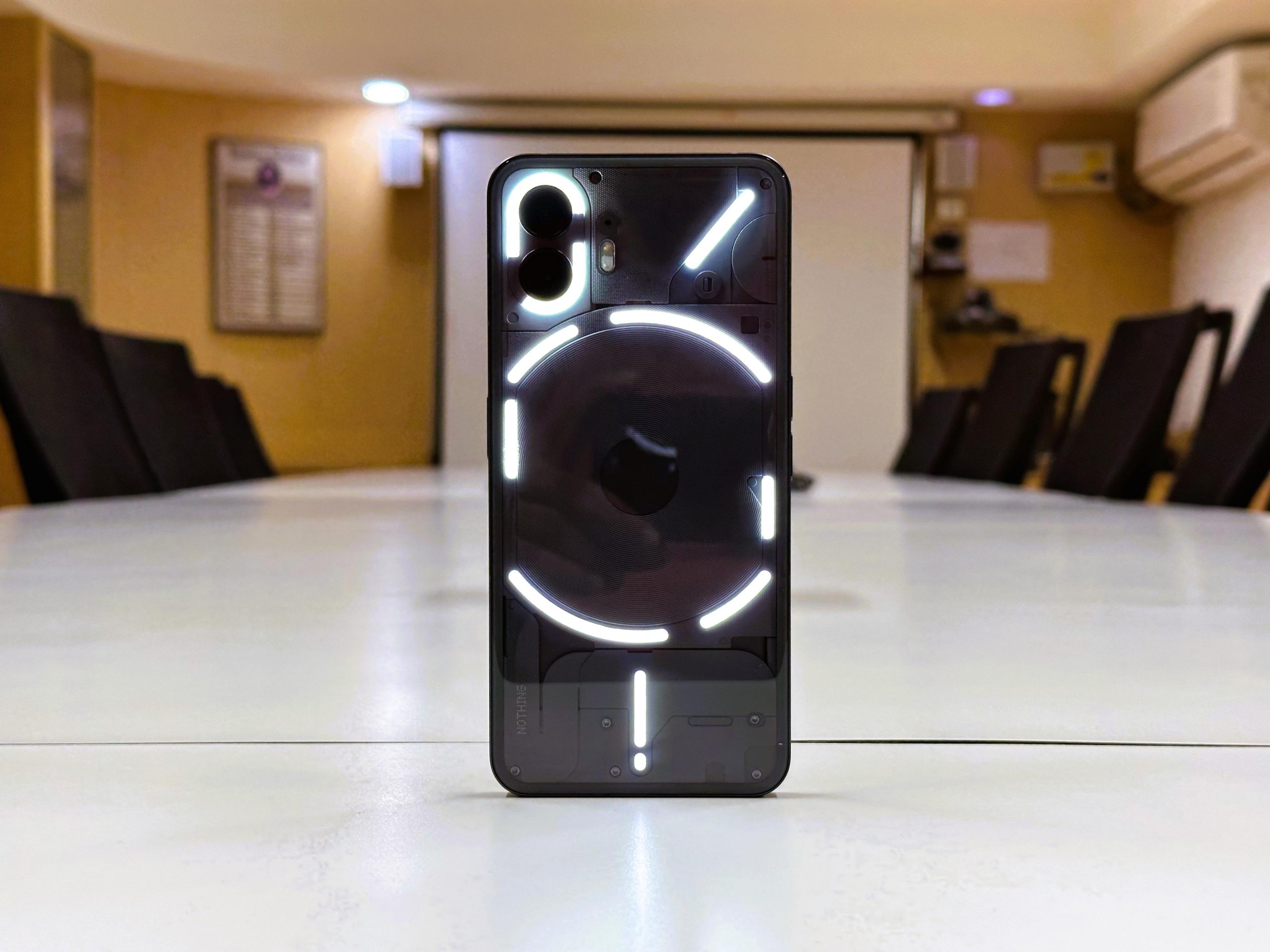The Phone (2) is a second-generation smartphone from London-based consumer technology start-up Nothing. Contrary to what many liked to believe initially, the smartphone is based on the first-generation model but with clear focus on design, experience, and performance. It is easy to draw a parallel between the Phone (1) and Phone (2) since both smartphones have a lot in common, but the latter has more to it than meets the eye. Do all the extras it brings over the Phone (1) justify the move to premium segment with prices starting at Rs 44,999? Let us find out:
Design
The Phone (2) has a polarising design, similar to Phone (1), with flat aluminium frame and transparent back cover made of glass. Despite being a tad bigger, thicker, and heavier than the predecessor, the second-generation smartphone offers better in-hand experience since the weight distribution is right on point and the back glass cover has curvature on all sides that makes the phone feel thinner than it actually is. The overall fit and finish of the phone is premium. As for the protection, there is Gorilla Glass on both the front and the back glasses for resistance against scratches and smudges that it may otherwise get in everyday use abuse. The phone is IP54 rated for splash and dust resistance.
Display and audio
The Phone (2) sports a flat 6.7-inch 10-bit fullHD+ AMOLED display. It is an LTPO panel capable of dynamically switching refresh rate between 1Hz-120Hz. The display dominates the entire front profile of the smartphone with symmetrical bezels on all sides. With no plastic bracket, the display sits flush in the chassis and feels natural to use with gesture navigation.
The display is bright and responsive with good sunlight legibility. Though HDR10+ certified, the support extends to only YouTube. The display is colour-rich and responsive. It auto adjusts the refresh rate based on content requirements to conserve battery without compromising smooth performance. However, the refresh rate is not optimised for always-on display mode. Set at 120Hz by default, display always-on drains the battery and hurts the phone’s stand-by time.
The visual experience is complemented by audio, which is taken care of by stereo speakers. These are loud and clear but lacks depth, balance, and clarity. That said, the audio seems wanting in prowess.
Camera
Like the Phone (1), the Phone (2) has dual 50-megapixel camera set-up on the back. However, the main camera sensor has been upgraded to Sony IMX890. On the front, there is a 32MP camera sensor.
Details aside, there is a bump in imaging experience compared to the predecessor. It is a result of both upgrades in the main camera sensor and optimisations at software level. However, the overall imaging experience is far from what you expect from a smartphone in this segment.
The primary camera sensor is good with regard to capturing colours, contrast, and details. It works fine in varied lighting conditions. However, there is a noticeable shutter lag and the sensor is inconsistent with dynamic range. Moreover, portrait is not something it is capable of capturing with fineness since there usually is an unnatural overlap of the background bokeh on the subject contours. Nevertheless, the sensor works best in photo mode. It is capable of generating natural shallow depth-of-field, which adds zing to otherwise mundane frames.
The ultra-wide-angle sensor, carried over from the Phone (1), is modest at best. There is no colour symmetry between the shots taken from the main sensor and the ultra-wide-angle sensor. Moreover, the ultra-wide-angle sensor softens the frame around the edges. In low-light conditions, it struggles in capturing details and often mixes shadows with highlights.
As for the front camera, it is good but works at its best only in moderate light conditions. In harsh sunny outdoors, it struggles with dynamic range and often overexposes the frame. It is not a bright sensor, thus, struggles in low light conditions.
Coming to the videos, both the rear cameras can do 4K at 60fps. However, you cannot switch between the sensors while recording. The front camera peaks at 1080p at 60fps.
Performance
Powered by Qualcomm Snapdragon 8+ Gen 1 system-on-chip, the Phone (2) brings significant performance boost over the first-generation model. If not better, the performance here is on par with the smartphone in its segment. The overall experience is snappy, and the phone delivers consistent performance even after extended usage. Power-and-graphic intensive tasks such as gaming and multimedia editing make the phone go warm, especially after long sessions. However, the thermals barely cross the comfort threshold.
Software
The Phone (2) may appear to have its share of hits and misses in other areas, but it excels in terms of user experience. It runs on the Android 13 operating system-based NothingOS 2, boasting a clean and user-friendly interface. In addition to the stock Android-like interface, Nothing has introduced a monochrome theme that removes colours from the interface and app icons. While the monochrome theme lacks some polish, as certain third-party apps do not support it, it still presents an appealing appearance—especially when paired with Nothing and Google apps and widgets on the home screen.
Speaking of widgets, Nothing offers an extensive selection for the home screen, lock screen, and always-on display. Furthermore, the update introduces new spacious folders with the ability to customise folder icons. Even the folder style can be personalised to suit individual preferences. Evidently, NothingOS 2 prioritises customisation to provide a personalised and tailored experience, and it undoubtedly delivers on this front.
Glyph Interface
Nothing’s commitment to providing a personalised experience through customisation extends to its Glyph Interface. In addition to more than doubling the number of addressable LED zones, which are divided into distinct sections, Nothing has enhanced functionality and introduced new tools to maximize the potential of its lighting interface.
One notable addition is the utilisation of the arch-shaped LED located on the top side of the wireless charging coil. This LED now serves as a countdown timer and volume level indicator, offering users increased versatility. Additionally, a Glyph composer tool has been included, allowing users to create custom ringtones paired with light patterns based on Nothing sounds.
However, the most valuable feature of the Glyph interface is the Essential notification. This feature enables users to assign LED visual indicators to all notifications or specific actions from apps. These notifications illuminate the LED strip until they are either read or dismissed, ensuring important information is easily noticed.
These new functionalities and tools complement the existing features already available within the Glyph interface, further enhancing the overall user experience.
Battery
Powered by a 4,700 mAh battery, the Phone (2) sails through a day on regular usage with display always-on mode disabled. The display always-on mode does not hamper the screen-on time, but it hampers the phone’s stand-by time. For reference, the display always-on mode drains about 15 per cent battery overnight. As for charging, the Phone (2) supports 45W wired charging over programmable power supply (PPS) standard. However, it does not come with a compatible adaptor, but just the two-way USB-C cable. Like the predecessor, there is support for 15W wireless charging (Qi) and 5W reverse wireless charging.
Verdict
The Nothing Phone (2) offers a neat blend of familiar design and novel user experience. While it may not be flawless, its reasonable pricing matches the overall package, emphasising design, user experience, and performance. With the exception of imaging, the smartphone excels in every aspect when compared to its peers in the same segment. Additionally, its clean and optimised user interface further solidifies the Nothing Phone (2) as a smartphone to consider in the segment dominated by Google, OnePlus, and Samsung.
Note:- (Not all news on the site expresses the point of view of the site, but we transmit this news automatically and translate it through programmatic technology on the site and not from a human editor. The content is auto-generated from a syndicated feed.))



